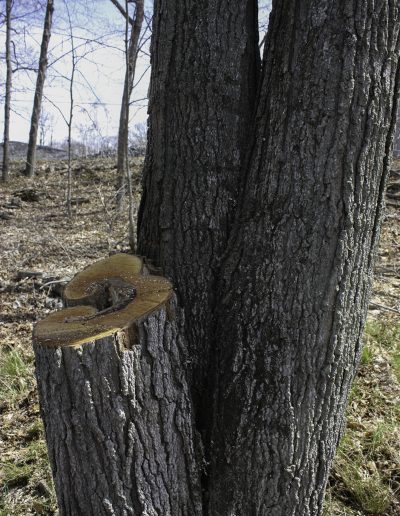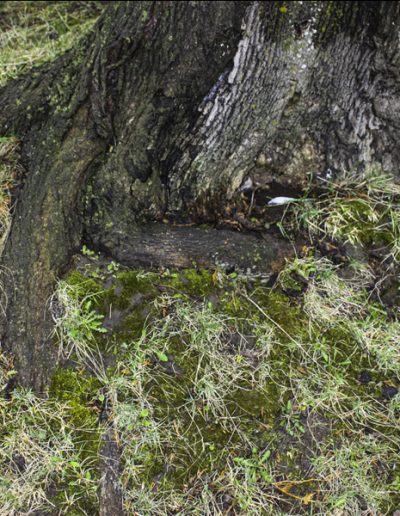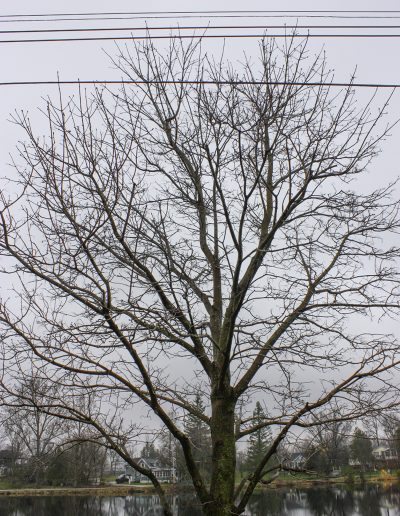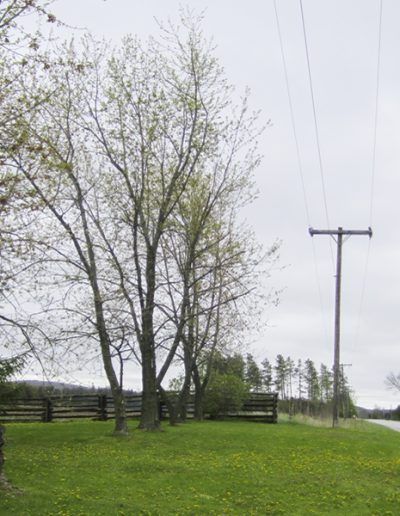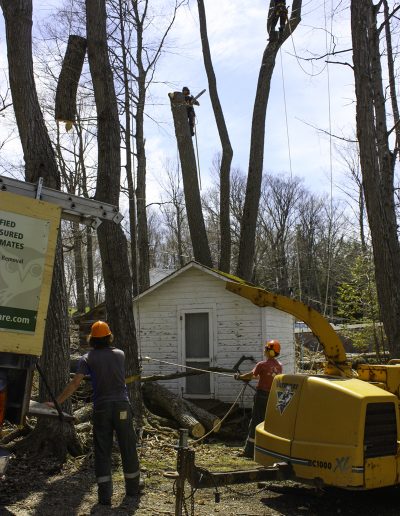Services
We offer a wide range of services including:
- Mature Pruning
- Training Pruning
- Hazardous Tree Removal
- Planting
- Stump grinding
- Consultation
- Cabling
- Deep Root Feeding
- Insurance Claims
- 24 Hour Emergency Service

Mature Pruning
Mature trees need pruning for many reasons including: structural problems, deadwood, encroaching on neighbouring property, and improving views, to name just a few.
Common structural problems include: double stems, rubbing branches, and girdled roots. Double stems are the most common structural problem, and leading cause of tree failure. When a branch emerges at an upright angle, parallel with the stem, the emerging branch eventually competes with the main stem for dominance. As the tree matures, both stems thicken, each adding to their girth and gradually pushing against each other as they grow. Eventually the pressure this growth exerts on each stem will result in the failure of one or both stems.
This type of tree failure can easily be avoided if corrective pruning is done when the tree is young. Older trees, however, may have several stems that will require gradual pruning over a number of years to fully correct the problem. Professional advice is key; first to assess the situation and secondly to formulate a plan.
Branches rubbing and crossing each other is another very common structural problem. Correcting this problem is a small and easy task, if pruned when the tree is young. If left too long, however, the bark can become damaged and the branch can die. Disease may then infect this and neighbouring branches. Pruning is needed to remove the physical contact between the branches, as well as any surrounding dead or diseased wood.
Another type of crossing that can cause tree failure is girdled roots. Girdled roots are roots that cross over each other, muchl ike crossing branches.
At the base of the tree where it contacts the ground, roots should radiate out in all directions and the trunk should widen. This is called “rootflare”. A lack of root flare is a sign that girdled roots may be a problem.
If a root turns back and crosses over other roots, it will strangle the crossed roots as it grows.This compromises the anchoring of the tree and the nurturing capacity of the root system. If corrected early, the tree can safely continue growing to maturity.
Timely pruning can address all the issues a tree faces, and greatly prolong its life and beauty. A mature tree can be monitored and pruned before problems escalate to the point where removal becomes the only option.
CLICK ON THE IMAGES TO SEE FULL SIZE VERSIONS >

Training Pruning
Young trees can benefit from, and in fact demand, pruning to correct potential problems. Be they double stems, rubbing branches, or girdled roots, all of these structural problems can be easily corrected when the tree is young. Failure to do so may result in a more expensive intervention down the road.
The double stem on this young tree is easily corrected with a simple pruning which will prolong the life of the tree and prevent potential property damage.
Patience is important. While young, the tree needs all the leaf area it can get to produce a thick, healthy trunk. Prematurely cutting back too much at a young age can undermine a tree’s proper structural development.
CLICK ON THE IMAGES TO SEE FULL SIZE VERSIONS >

Hazardous Tree Removal
There are many circumstances that can render a tree hazardous: storm damage, structural problems, environmental hazards such as disease, overhead wires, or proximity to buildings or other property.
After a storm, trees can be pushed into positions that are very hazardous to deal with. A tree on the ground may look safe to cut but can be under great tension, ready to spring, causing further damage to people and property. If you have a tree which has been damaged in a storm, call a professional tree service to come and assess the situation, and to remove immediate hazards. If your tree is on municipal property, alert your publicworks department of the hazard and they will send a crew to deal with it as soon as possible.
Eventually trees weaken due to age, root disturbance, physical injury, and many other reasons. When a tree is in decline its weakened state literally sends out a signal alerting insects to its condition. They respond by infecting the tree, thereby speeding up the decline and contributing to a hazardous condition. It is important to be aware of neighbouring trees of the same species that might also become infected. For this reason, it is important to respond quickly and remove any of the felled tree’s wood.
Trees in or near wires require special care. Every situation requires careful assessment of clearance and safety measures. Depending on the situation, the tree may be in a jurisdiction that should not be dealt with by a private tree company.We can advise you of your next step: should you call the city, hydro or another authority?
Whether a tree is diseased, at risk of failing, or has over grown it’s space and is encroaching on buildings, it’s wise to consult with a professional arborist. A professional assessment is important to determine the rate of decline in order to decide if pruning is an option or if removal is required. We offer free quotations that include an assessment of the situation and advise on how best to proceed. We will discuss with you relevant issues such as: property lines, septic tank locations,hydro and phone lines, etc. Our trained arborists are adept at many skills and techniques, allowing us to use whatever the situation calls for: cranes, man lifts, lowering ropes, etc. Whether big or small we will do the job courteously and professionally. Your satisfaction is our goal and promise for success. And, we do it all in a lean, efficient manner.
CLICK ON THE IMAGES TO SEE FULL SIZE VERSIONS >

Planting
If you haven’t bought a tree already, the first thing to do is discuss with us your desires for the space in which you want to plant. We can advise which species could do well in that location, or discuss other planting locations that might work as well, if not better.
Next we do the planting. The size of the tree depends on your budget and location. The tree is secured with proper staking until it can support itself, usually a year or so, at which time we remove the supports.
Finally, maintain the new planting: Compost and mulch for nutrients is placed around the tree at planting and replenished regularly (each season) if requested.
Pruning as needed is done after two years and again if needed.

Stump Grinding
When all that is left of a tree is a stump, it is time to look at ways of rejuvenating the space.
What could best be done with the space, and when, are important considerations.
Often, all that is needed is to remove enough of the stump to turf over the area, so the stump only has to be ground a few inches below soil level.
Sometimes planting a new tree nearby is necessary. This involves more thoughtful considerations, such as:
1. Was the old tree diseased? If so, then the root system might infect a new plant.
2. What species was the old tree and what species is the new tree? There may be incompatibility issues between the two species.
3. How close will the new planting be to the old stump? Grinding significantly deeper than just a few inches may be required. Always call the toll free number 1-800-400-2255 first, however, to have underground pipes and wires located and marked.
Finally, if you are willing to let nature take care of the stump naturally then there are plants that love to feed on stumps and so do very well planted on or near stumps. It will take a few years but it is cheaper and easier.
CLICK ON THE IMAGES TO SEE FULL SIZE VERSIONS >
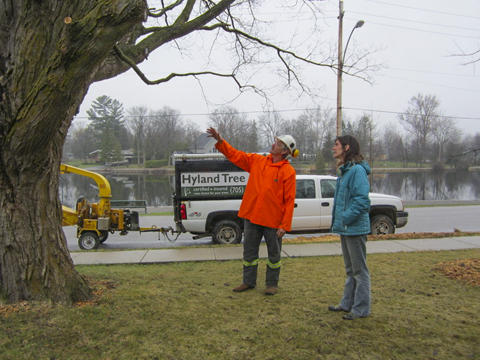
Consultation
Consultation is an in-depth, ongoing service to provide professional advice to meet your needs. An on-site estimate, which is a free service, is essentially an initial free consultation.
If the size and scope of the job involve consultation visits beyond the initial estimate, those costs would be stated in the estimate.
For example, I have been invited to come on site for a residential construction job where the customer wanted some opinions on how to best preserve the trees. I gave an estimate which involved checking the site and the tree’s condition. That was free. The customer wanted further visits to oversee the situation. Those further visits were paid consultation visits.

Cabling
Cabling and/or bolting can help make a tree more secure. However, it also complicates the situation in the long term. Thorough discussion is needed to determine the suitability of cabling vs. pruning.
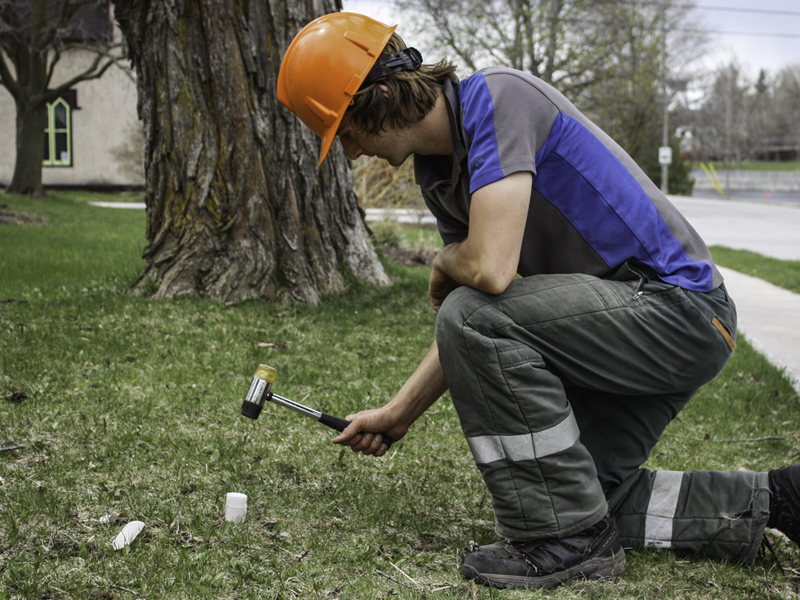
Deep Root Feeding and Aeration
Soil can become compacted because of: cars parked under trees, foot traffic, or construction equipment to name just a few examples. Compacting of soil around trees prevents water and oxygen from being able to reach the roots. This compromises the tree’s ability to thrive. Deeproot aerating can help loosen up soil allowing water and nutrients to flow to the tree’s roots. We do this by creating holes up to 18” deep in the soil to alleviate the compaction. In addition, if the tree shows signs of nutrient deficiency, nutrients can be applied to the aerated soil.
CLICK ON THE IMAGES TO SEE FULL SIZE VERSIONS >
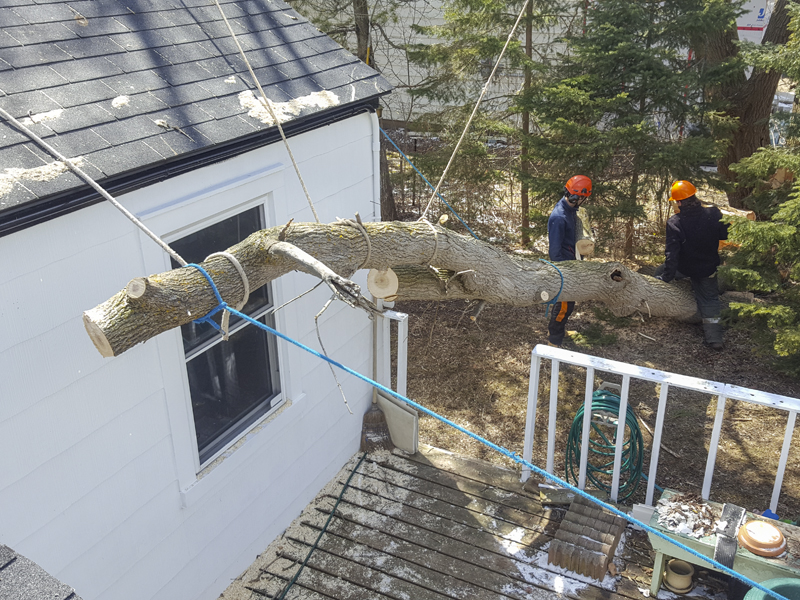
Insurance Claims
Hyland Tree Care is registered with a number of agencies if insurance work is required.
24 Hour Emergency Service
We can respond anytime of day to serve your needs in an emergency.

